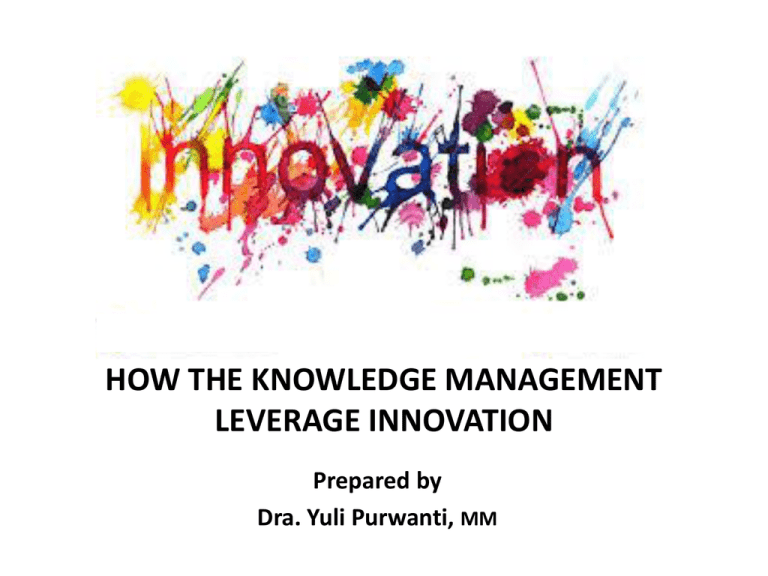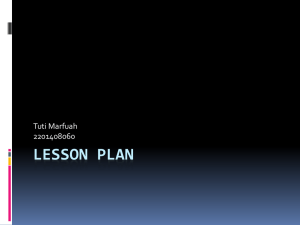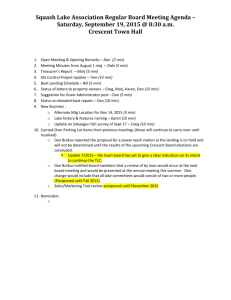Knowledge - Telkom University
advertisement

HOW THE KNOWLEDGE MANAGEMENT LEVERAGE INNOVATION Prepared by Dra. Yuli Purwanti, MM Approach Knowledge Management is not a cookbook. It’s OK to make mistake Coach, mentor and support one another There is sometimes no absulate answer but probably better solution An understanding of the underlying principles and processes is more important than just the content and tools WHAT & WHY KM Makna MEA 2015 Pada Perekonomian Tantangan Global Ekonomi Indonesia 2015 1. Perlambatan ekonomi China. Perlambatan pertumbuhan China sejalan dengan upaya pemerintah untuk memperlambat pertumbuhan kredit terutama pada sektor real estate. Ekspor Indonesia ke China sekitar 11 persen. 2. Ancaman Capital Outflow. Perbaikan ekonomi AS akan berdampak pada penurunan stimulus moneter oleh the Fed. Perbaikan indikator ekonomi AS akan mendorong kenaikan suku bunga dan diproyeksi akan mendorong capital outflow serta memberikan dampak lanjutan seperti depresiasi nilai tukar. 3. Implementasi Masyarakat Ekonomi ASEAN. Indonesia tertinggal pada seluruh indikator seperti infrastruktur, pembiayaan, hingga sumberdaya manusia. Indonesia hanya unggul dari jumlah penduduk dan menjadi salah satu pasar potensial bagi negara lain. PERINGKAT ECONOMI DIGITAL TAHUN 2010 PERKEMBANGAN PASAR TELEKOMUNIKASI DUNIA DIPIMPIN ASIA 6 PERKEMBANGAN JUMLAH PELANGGAN DIDOMINASI CHINA DAN INDONESIA Sumber: PWC, 2012 7 PERKEMBANGAN PASAR TELEPON SELULER 8 Social Capital Psychological Capital Individuals who have a global mindset Intellectual Capital Individuals who possess the behavioral flexibility and discipline to act appropriately Individuals who are capable of perceiving, analyzing and decoding the global operating environment Individuals who can accurately identify effective managerial action in the global operating environment Behavioral Repertoire Global MIndset Global Leaders who are effective in influencing people from different sociocultural systems The Corporation’s ambition to be successful in global markets What is the game? What are the rules? How do we win? Reff. Thunderbird Business School of Management Global Mindset versi Thunderbird Windows on the world NORTHERN VALUES Reliability Rigor Discipline Consistency System Caution WESTERN VALUES EASTERN VALUES Individuality Speed Harmony Predictability Empowerment Efficiency Consensus Modesty Productivity Directness Blending in Indirectness SOUTHERN VALUES Loyalty Instinct Relationships Spontaneity Hierarchy Adaptability Kunci Sukses MEA Menurut BJ Habibie Mengapa Harus Knowledge Enterprise Knowledge Strategy Knowledge Needs 9 Kompetensi KM Need Culture & Leadership What is Knowledge ? What is Knowledge ? Knowledge merupakan sebuah gabungan aliran pengalaman, nilai-nilai, informasi kontekstual, dan wawasan pakar yang menyediakan satu kerangka untuk mengevaluasi dan membentuk pengalaman dan informasi baru. Berasal dan digunakan di dalam pikiran pemilik pengetahuan (the knowers). Dalam organisasi, seringkali melekat tidak hanya di dalam dokumen atau repositories melainkan juga di dalam (pekerjaan) rutin, proses, praktik dan norma organisasi. What is Knowledge Management (KM) ? KM is a holistic management discipline with rapidly emerging new strategies, innovations, methods, tools, and Techniques Suatu proses atau upaya yang dilakukan secara sistematis, efektif, aktif dan cerdas untuk mengelola knowledge baik yang eksplisit maupun tacit, dengan dukungan perangkat teknologi informasi, manusia, dan lingkungan organisasi yang baik untuk mencapai tujuan organisasi Disiplin perusahaan untuk mengelola dan memanfaatkan aset-aset intelektual, termasuk data digital, pengetahuan tentang best practice, kompetitor dan kastamer, keahlian, pengalaman dan gagasan dari pegawai. KM is like learning to drive There’s a big difference between: Doing the theory test Sitting in the front passenger seat while someone else drives Actually driving the car yourself “Driving” KM General awareness is one thing… …understanding is quite another A commonly heard cry is that “we know about knowledge management as a concept, but how do we do it?” Do: Lead from the top Make sure to cut across boundaries Think in terms of an ongoing KM activity, not a “project” that is done and finished Don’t: Go against the organization’s culture Expect people (or systems) to change overnight Ignore the exceptions to the process • Tacit Knowledge – Melekat di dalam pikiran individu – Merupakan satu keluaran dari masyarakat sosial, baik individu maupun kelompok – Merupakan know-how individu dan konteksnya ditambah melalui pengalaman dan interaksi. – Contoh : Personal Skills, Beliefs, Values, Ideas, Creativity, Insight, Innovation. • Explicit Knowledge – Mudah di-share di antara orang-orang sekali ia dikodifikasi dan disimpan di dalam sebuah pusat penyimpan, menjadikannya dapat diakses oleh semua orang – Terstruktur dan memuat item-item seperti: kebijakan, prosedur, paten, trademarks, penelitian dan trade skills – Ditemukan di dalam proses atau rutin yang mengikuti beberapa set logical guidelines yang ditetapkan sebelumnya. People, processes and technology Directories, Communities of Practice PEOPLE Help design and then operate Provides support for Help design and then use Repositories, Knowledgebased Systems TECHNOLOGY Define the roles of, and knowledge needed by PROCESSES Makes possible new kinds of Determine the need for New ways to work, build in what you want to achieve HOW TO IMPLEMENT Constraint Issue to share Knowledge Cultural Barrier Knowledge is Power Poor Competency / Knowledge Comfort zone Poor Recognition Lack of Time Creating Collaborative Environment of K-Sharing Individual Level • Encourage employee involving in Knowledge Sharing Group Level • Building Community of Practice Corporate Level • Providing Compentence based Knowledge KM FRAMEWORK MAKE Framework Organizational Value Organizational Learning Innovation Customer Knowledge Intellectual Capital Management Knowledge Sharing and Collaboration Organizational Culture Value KM in Business Reality KM Activities Foundation of Knowledge Base Organization Leadership Based on MAKE Framework Teleos Apple The 2012 Global MAKE panel has recognized Apple for creating a knowledge-driven organizational culture (1st place), developing knowledge-base products/services/solutions (1st place), maximizing its enterprise intellectual capital (1st place), and transforming enterprise knowledge into shareholder value (1st place). This is the seventh year in a row that Apple has been recognized as a Global MAKE Winner, including overall 2009, 2011 and 2012 Global MAKE Winner. Google (United States) Google is recognized in the 2012 Global MAKE study for developing knowledge-based products/services/solutions, and maximizing enterprise intellectual capital. This is the eight consecutive year that the company has been recognized as a Global MAKE Winner, including overall 2010 Global MAKE Winner. Samsung (South Korea) The 2012 Global MAKE panel has recognized Samsung for creating a knowledge-driven organizational culture, and organizational learning. This is the ninth consecutive year that Samsung has been recognized as a Global MAKE Winner. Toyota (Japan) The 2012 Global MAKE panel has recognized Toyota for maximizing enterprise intellectual capital. Toyota is a 10-time Global MAKE Winner, including overall 2005 and 2006 Global MAKE Winner. Telkom Knowledge Management Framework The Best TIMES Enterprise Stakeholder Value Knowledge Enterprise System Knowldege Leader: BOD as a Dean, CKO Knowledge Expert: Expert KM, Expert TCU-C Knowledge Creator: Stakeholder Knowledge User: Stakeholder People • • • • Knowledge Knowledge Knowledge Knowledge Leader Expert Creator User “Knowledge based Enterprise” Innovation Employee Learning Solution Based Learning Collaborative Problem-Solving Decision Making Knowledge ReUse Customer Knowledge Result: People guided by knowledge Process • Knowledge Acquisition • Knowledge Refinement • Knowledge Sharing • Knowledge Utilization Infrastructure IT Broadband Infrastructure KM System The Telkom Way IT Broadband Network KM System : Kampiun, Telkom Tube, i-Connect, Website Telkom, Telkom Portal, Digital Learning “Knowledge is actively shared” Silaturahmi Patriot 135 Community of Practice Employee Contribution Leader as Father Knowledge Day , DSH, IL@W Result: Knowledge Dissemination “Built & empowered it” IT Broadband Network KM System • Kampiun • Telkom Tube • Telkom Website • Telkom Portal • Digital Learning • i-Connect Result: Knowledge Accessibility Process “Knowledge is codified & standardized” Knowledge is filtered and synthesized Explicit knowledge is formatted, evaluated, and selected. Result: Relevant Quality Content “Knowledge based on Competence” Knowledge need Inventory Knowledge source identification Knowledge Searching and Collecting Business Case Study Result: Knowledge Repository Google : Turning Problem into Innovation Google : Organizational Culture Problem Issues (1) Knowing is not enough; we must apply. Willing is not enough; we must do. Johann Wolfgang von Goethe Being different can be a GOOD thing. The Fairy Tale of Ugly Duckling Establishing Enterprise Knowledge Culture Develop and deploy knowledge-based enterprise vision and strategy Articulate knowledge-based enterprise vision through mission statement Determine enterprise core competencies (knowledge assets) Design knowledge-based enterprise structure and relationships between enterprise units Develop and manage enterprise knowledge values Creating and Sustaining Management Leadership/Support for Managing Knowledge Develop and deploy enterprise management style which encourages the acquisition, sharing and application of knowledge Provide financial and non-financial support for managing knowledge Operate a knowledge council to ensure deployment of knowledge strategy Deploy enterprise knowledge strategy under guidance of chief knowledge officer Encourage and support enterprise knowledge strategy and approach Develop and train knowledge leaders Recognize/reward knowledge leaders Measure effectiveness of knowledge leaders Communicate/report enterprise management leadership/support for managing knowledge Delivering Knowledge-Driven Products/Services/Solutions Developing and deploying an enterprise knowledge creation and innovation strategy Developing and training the workforce in idea generation and innovation Involving customers and suppliers in the development of knowledgebased goods and services Increasing/expanding enterprise knowledge Managing the transfer of knowledge and ideas to ‘points of action’ Recognizing/rewarding innovators Managing the production and/or service of knowledge-based goods and services Measuring value created from knowledge creation and innovation Innovation • Employees are allowed free time to be creative • Functional barriers are removed and ‘silo’ mentalities discouraged • Employees are allowed to take risks and to make mistakes • Organizations create reward systems which encourage innovation • Networks and communities of practice are encouraged • Customers are integrated into the creative process – problems are looked at from the customers’ perspective • The innovation process is under continuous review and improvement Maximizing Enterprise Intellectual Capital • Developing and deploying an enterprise intellectual capital strategy • Developing and training the enterprise workforce in intellectual capital concepts and tools • Developing tools and techniques to manage and measure intellectual capital • Managing and expanding intellectual capital • Protecting knowledge assets • Recognizing/rewarding employees enterprise intellectual capital for increasing Creating and Sustaining Environment of Knowledge Sharing Develop and deploy enterprise knowledge sharing strategy Develop and train workforce in knowledge sharing concepts and tools Develop tools and techniques for knowledge sharing (e.g., Internet, intranets, communities of practice, teamworking) Manage and improve knowledge value chain Manage and promote knowledge sharing Develop knowledge sharing concepts and skills Develop and manage knowledge sharing Use collaborative tools for knowledge sharing Creating and Sustaining Environment of Knowledge Sharing (cont’d) • Support communities of practice • Develop and maintain corporate intranets for knowledge sharing • Develop and manage knowledge databases • Transfer best practices gained from knowledge sharing • Recognize/reward employees for knowledge sharing • Measure enterprise value creation from knowledge sharing • Communicate/report value creation from knowledge sharing Creating a Learning Organization • Developing a knowledge-based enterprise learning strategy • Developing collaboration/partnerships for accelerated learning • Developing and/or acquiring learning methodologies, tools and techniques • Converting tacit into explicit knowledge • Developing communities of practice • Learning by doing • Coaching and mentoring • Developing an organizational learning infrastructure, e.g., corporate intranet for the internal and external exchange of learning experiences • Moving from individual learning to organizational learning Delivering Value Based on Customer Knowledge Developing and deploying an enterprise knowledge-driven customer value management strategy Creating and managing customer value profiles and maps Creating customer value chains Developing and/or acquiring tools and techniques to collect and gain value from customer knowledge Developing and managing customer databases Developing tools and techniques to extract value from customer knowledge Measuring changes in the customer value chain Transforming Enterprise Knowledge into Shareholder Value • Developing and deploying an enterprise knowledge-driven strategy for increasing shareholder value • Mapping and developing knowledge value chains • Managing and measuring knowledge value chains • Measuring changes in enterprise shareholder value • Communicating/reporting on knowledge-based value creation References : • Knowledge Associates Module, 2009 • KNOWS Network • Patrick Lambe, Strait Knowledge, 2011 • Aston Business School, A Process View of Knowledge Management, 2010 • Ronald Meier, Re-Focusing Knowledge Management, 2011







